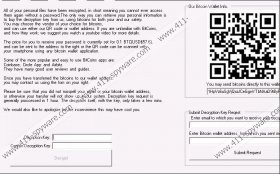Nullbyte Ransomware Removal Guide
Nullbyte Ransomware has been wreaking havoc recently, and it is time to put a stop to it. This malicious program is set to encrypt your files, block the Task manager, and deny you access to CMD.exe. It will also demand that you pay a ransom to get your files back and restore your PC to working order. However, we urge you not to comply with the demand to pay and remove this infection using our guide or an antimalware tool. If you want to know more about this program, then we invite you to read this full article.
If this malicious application happens to infect your computer, then it will encrypt all of the files stored on it, but it will skip some locations needed to run the operating system. It uses the AES encryption algorithm to encrypt the files, and this encryption method is quite strong, so decrypting the files is a rather default if not impossible task. While encrypting the files, this ransomware adds the _nullbyte extension to them, which serves as an indication that a file has been encrypted. When a file becomes encrypted, you cannot open it and access its content, so it is effectively corrupted.
The person behind Nullbyte Ransomware wants you to pay a modest ransom of 0.1 BTC (57.6 USD) which is a reasonable sum of money. You can risk paying the ransom to get the decryption key, but there is no guarantee that you will get it or that it will work. Note that you can pay the ransom in Bitcoins only because that way its creator will not get caught by the authorities. Once the encryption is complete, this ransomware will enable its GUI and present you with the ransom note. The GUI features several dialog boxes to which you have to enter your Bitcoin wallet address, email address, and decryption key once and if you get it.
It is also important to say that you cannot close this ransomware’s GUI window, and it is set to be on top of other windows at all times. Still, if you opt to delete this program using an antimalware tool, then you can move this ransomware’s window to the side to launch whatever tool you opt for. Furthermore, it will deny you access to Task Manager and CMD, thus restricting access to certain features.
Now let us point your attention to how this application is disseminated because it might help you avoid getting this ransomware if you do not already have it on your PC. Our research has revealed that Nullbyte Ransomware comes secretly bundled with an application called Necrobot, a cheating program for PokemonGo. Take note that this ransomware can be found bundled with Necrobot only if this program is featured on malicious websites. Nevertheless, this is not the only method used to distribute this infection. We have also found that this ransowmare’s executable is zipped in a file archive and sent in spam mail as an attachment. When you open this attachment, the ransom will be dropped on your PC and initiate immediately.
As you can see, Nullbyte Ransomware is one malicious application that is distributed using deceptive means and is meant to infect your computer silently. Once on your PC, it is set to encrypt your files and ask for a modest ransom, but there is no way of knowing whether you will get the decryption key after paying it. For this reason, we suggest deleting it using SpyHunter or our manual removal guide and wait till security researchers develop a proper and free decryption tool.
How to delete this ransomware
- Hold down Windows+E keys.
- In the File Explorer’s address box, type the following locations.
- %USERPROFILE%\Downloads
- %USERPROFILE%\Desktop
- %TEMP%
- Find the malicious executable.
- Right-click it and click Delete.
- Empty the Recycle Bin
Nullbyte Ransomware Screenshots:



